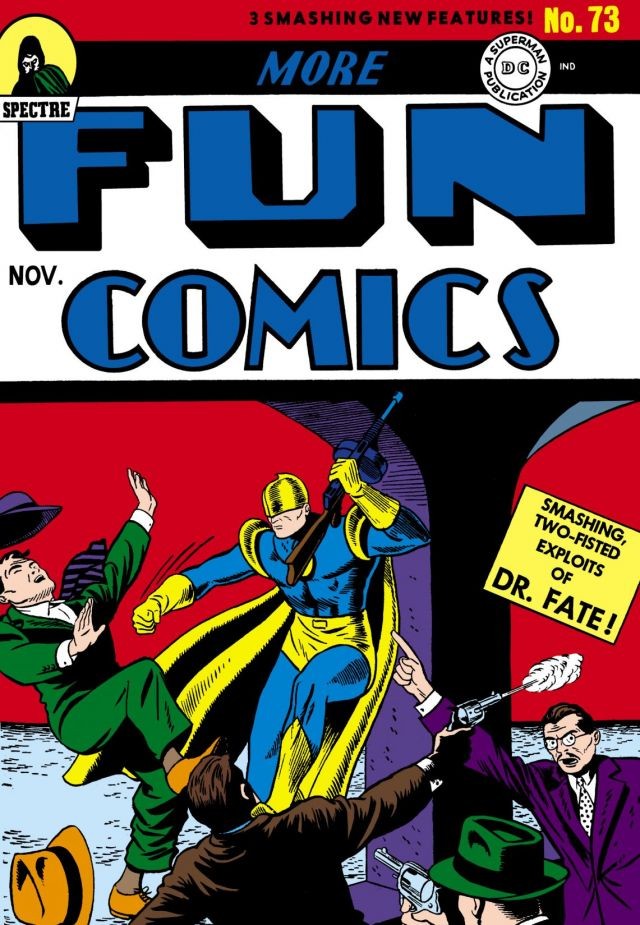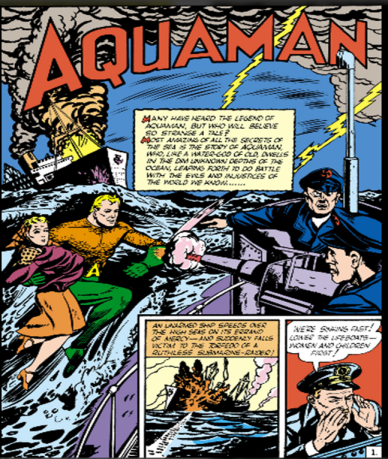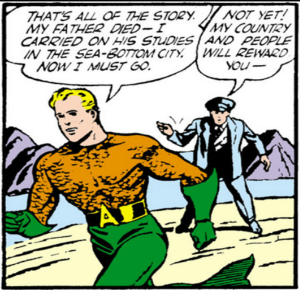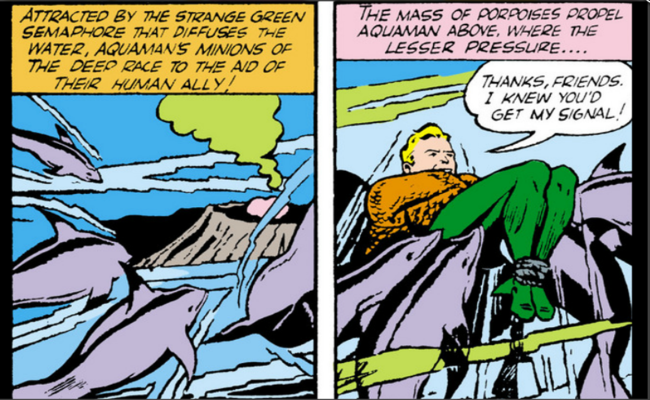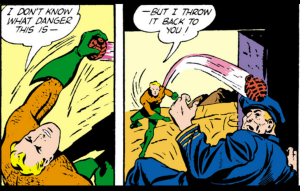 December
04
December
04
Tags
Retro Review: More Fun Comics #73 (1941) – “The Submarine Strikes”
Retro Review takes a look at influential issues of DC comic books and measures their artistic integrity against their cultural and symbolic importance to the DC Universe and comic books in general.
More Fun Comics #73 (1941) – “The Submarine Strikes”
Written by Mort Weisinger
Art by Paul Norris
Published: November 1941 (National Allied Publications)
Grade: C
Aquaman is one of the most maligned heroes in the DC Universe, if not all of comics, often shrugged off as a second-rank hero whose powers are viewed largely as uncool and useless. Despite this, Aquaman is one of DC’s oldest superheroes and has headlined seven different volumes of his own solo title over the course of over seven decades. In the Silver Age, he even became one of the founding members of the Justice League. So how can such an iconic hero become such an industry and pop-culture in-joke? There are, of course, a myriad of reasons for this, but I can’t help but think that the entire character got off on the wrong foot.
Aquaman was created by writer Mort Weisinger and artist Paul Norris, and made his debut as a backup feature in More Fun Comics #73 in 1941 – the issue which also features the debut of Green Arrow. As a backup feature, the character was effectively meant to fill space in the anthology – the primary features of Doctor Fate and The Spectre were already incredibly popular and it’s doubtful that anyone thought Aquaman would be a serious rival for those heroes. As such, the story is very simple: a Nazi U-Boat attacks “a defenseless ship…carrying refugees and hospital workers” when Aquaman intervenes, saving the passengers and explaining his origin before pursuing the attackers to their island base. In some ways, it’s a very clean and easy 8 page introduction to a brand new character, but there is a difference between a story being simple and one being facile. This one is the latter.
Weisinger’s writing starts off well enough, quickly opening on the conflict between the peaceful vessel and the attacking U-Boat. The pace is fast and energetic, with enough danger to hook you early, but not so much that it becomes a dark portrayal of war. In fact, the quick pace and moderate tone bear the marks of what could have been a truly exceptional comic (for the era), but by the third page it all begins to unwind. Aquaman’s dialogue is among the worst in the entire story, and starting on page three it is painfully clear that Weisinger has no voice for the character. His stilted expositional origin tale could very well have been placed in captions at the top of the story for all the difference it would have made – Aquaman sounds little different from the narrator of the previous two pages. The rare instances in which we catch a glimpse of character are when Aquaman is discovering the surface world; eg. referring to the U-Boat as a “metal fish”. But this nuance in the dialogue is erased a mere page later when Aquaman refers to hiding Nazis as rats in a sewer. How does a man who grew up at the bottom of the sea know about rats and sewers and not submarines? This is a question for Weisinger, I suppose. In fact, the only dialogue written less attentively than Aquaman’s is that of his father who, seeing his teenaged son frolicking in the ocean outside his undersea home, exclaims: “My son is a true dweller of the deep–His name shall be Aquaman!” So not only did our hero not have a name until he was almost an adult, but his birth name is Aquaman?
Norris’ art is not especially better. Despite strong lines, good anatomy, and a solid grasp of the basics of the artwork, Norris suffers from the same issue as his writing counterpart. Nazis and refugees show a whole range of facial emotion – surprise, anger, fear, joy – while Aquaman’s face conveys nothing at all. Like his dialogue, Aquaman’s face betrays no signs of character, personality, or emotion, leaving the whole experience of watching the hero pretty hollow. Unlike the opening panels of the comic, where explosions and action are smartly drawn, there is absolutely no sense of danger once Aquaman arrives on the scene. His physicality, like his visage, shows no sign of engagement, even when the tables turn and our hero is seemingly bound beyond his strength. In both cases, Weisinger and Norris seem to have it all wrong, displaying terrific instincts and talent in everything but the representation of their hero.
All of this is not to say that the story is without positives. One thing this story does exceptionally well is introduce readers very quickly to nearly all of Aquaman’s wide range of powers in only a few pages. His submarine speed and super-strength are displayed as he chases down and punches through the Nazi submarine, he communicates with a family of porpoises who assist in guiding lifeboats to shore, and of course his ability to breathe underwater is on display through the entirety of the comic. What is especially great about this display of his powers is that none of it feels forced or superfluous – even his marine communication powers are incredibly useful and indeed necessary in the context of the story. This is a difficult feat to accomplish, especially when introducing a brand new hero and wanting to showcase the entire range of their abilities. I view this as the single greatest success of “The Submarine Strikes”, succeeding where even the debut of Superman did not – the latter featuring bedrooms that were mysteriously guarded by steel doors just begging to be crushed like tin cans.
But for all the powers on display, the core problem with the story remains the same – Aquaman, the title character and primary hero, is dull. And it’s not because his powers are uncool or useless (this is the one thing that this issue conclusively proves to be false), it’s because Weisinger and Norris gave him none of the detail or attention that they gave to their supporting cast or their set pieces. There is a rich depth of storytelling possibility for a character who hails from the ocean – terrestrial and yet alien, as we to this day know very little about the aquatic frontier – but none of those possibilities mean anything if the character that channels them is too boring or inconsistent. It’s impossible to follow not only in terms of story, but in terms of a reader’s patience.
That is precisely the reason why Aquaman was relegated to a backup feature in More Fun Comics and later Adventure Comics for 20 years. It wasn’t until the Silver Age that Atlantis became anything more to the character than a passing reference – it finally became his heritage. And with that shift finally came a degree of passion and detail that allowed the character to take on a shape of his own; orphan, half-breed, King. Not long afterwards, Aquaman began a long and storied series of solo titles. His popularity has only increased with time, and Peter David’s landmark run of Aquaman during the 1990s is the title’s longest running volume. In the New 52, Geoff Johns’ interpretation of the character is now one of DC’s highest selling titles. It has taken decades of tireless reinterpretation and re-examination, but Aquaman titles have become both critical and commercial successes, finally shattering the idea that he is irrelevant or uncool; a near miraculous feat considering just how deep a hole Aquaman’s creators dug with his lacklustre, largely inconsequential first appearance.
More Fun Comics #73 is available in digital copy on the DC Comics website.
_________________________________________________________
Bonus thoughts:
– Aquaman lacks a voice of his own for most of this comic, but these two panels are, in my opinion, the perfect “fish out of water” cliché (literally).
– This story is yet another example of early Golden Age heroes having no qualms about killing evil-doers. Granted, these bad guys are Nazis, but the point still stands.
– Aquaman communicates with sea life not by telepathy or mental suggestion as he does in later interpretations, but by direct communication in each animal’s own language.
– The worst “hero” line ever delivered. Also, the plainest face.

